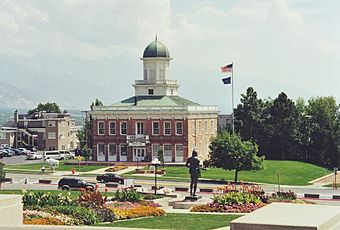Salt Lake City Council Hall facts for kids
|
Old City Hall
|
|

Council Hall as seen from in front of the State Capitol c. 2002
|
|
| Location | Salt Lake City, Utah |
|---|---|
| Area | less than one acre |
| Built | 1864 |
| Architect | William H. Folsom |
| NRHP reference No. | 71000846 |
Quick facts for kids Significant dates |
|
| Added to NRHP | May 14, 1971 |
| Designated NHL | May 15, 1975 |
The Salt Lake City Council Hall is an important building in Salt Lake City, Utah. Today, it holds the offices for the Utah Office of Tourism and the Utah Film Commission. You can find it on Capitol Hill.
This building was constructed between 1864 and 1866. It is famous because it used to be the Old Salt Lake City Hall from 1866 to 1894. In 1975, it was named a National Historic Landmark. This means it's a very special place that tells a story about the history of Utah Territory and the United States in the 1800s.
Contents
Building the Council Hall
The Council Hall was first built to be Salt Lake City's main government building. It replaced an older, smaller city hall that was too small for the fast-growing city. Planning for this new, bigger City Hall started around 1863.
Who Designed and Built It?
Work on the new hall began on February 8, 1864. It was led by William H. Folsom, a well-known architect in Salt Lake City. He was also the official architect for The Church of Jesus Christ of Latter-day Saints.
The building was made from sandstone brought from Red Butte Canyon. This stone was delivered using Utah's very first chartered railroad. The building was designed in the Greek revival style, which means it looked like ancient Greek temples. It cost about $70,000 to build, which was a lot of money back then!
When Was It Finished?
In January 1866, the City Hall was officially opened. George Q. Cannon, an important leader of The Church of Jesus Christ of Latter-day Saints, led the dedication ceremony. Many other leaders, including Brigham Young, were there.
At that time, a group called "The People's Party" was in charge of politics in the city and territory. This party was connected to The Church of Jesus Christ of Latter-day Saints. The mayor was Abraham O. Smoot, who was a member of The People's Party. He was the first of six mayors who worked in this building.
History of the Building
From 1866 until 1894, the City Hall was the center of Salt Lake City Government. It was also where the Utah Territorial legislature met to make laws. The mayor's office and other city departments were on the first floor.
Important Events at City Hall
The building saw many important moments. One dramatic event happened in August 1874. The mayor at the time, Daniel H. Wells, announced a special order from the balcony of City Hall. This happened because of disagreements between local officials and federal officers.
After 1899, the city used the Hall as its police headquarters until 1915. After that, the building was used for smaller city tasks.
Moving the Old City Hall
In 1961, the old City Hall was moved to Capitol Hill. This move was done to make space for a new federal office building downtown. The city and The Church of Jesus Christ of Latter-day Saints gave the building and its land to the state of Utah.
The Church also helped pay for most of the $300,000 cost to take the building apart. Workers carefully took the exterior apart into 325 sandstone slabs. Each slab was numbered so they could put it back together perfectly. The building was then rebuilt with new wood on Capitol Hill. The state of Utah paid for most of the landscaping and other work at its new spot, just south of the State Capitol. The restoration was mostly finished by 1962, and the building was renamed "Council Hall."



